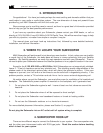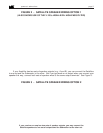
page 12powered subwoofers
the "BASS LEVEL" control slightly higher.
8. FINE-TUNING SUBWOOFER PLACEMENT
If you have the physical space in your room and the interest to experiment with the placement of
your Subwoofer, you may be able to optimize its location and sound. If you want to do this, listen to
the Subwoofer after it is hooked up, using a familiar CD, LP, or tape with good bass content. After you
move the subwoofer from one location to another, listen to the music again, paying attention to the
changes in the amount and quality of bass reproduction.
Ultimately, the amount and quality of bass you get in your room are very dependent on the room
itself. Low frequency bass sounds are affected most by the size of the room and the method of
construction used to build it. All rooms are different when it comes to reproducing bass, and in any
given room, bass quality changes when the Subwoofer is moved from one location to another.
A simple rule to remember is that you get more bass when you move the Subwoofer towards any
wall or corner. Moving it away from a wall or corner gives you less bass. Remember that the floor also
loads the Subwoofer, and that maximum bass is found with the woofer on the floor in a corner.
The Subwoofer will probably sound its best when it is on the floor, within a foot or two of one wall,
either in or within a few feet of a corner. This provides for good "loading" to the room, and is the best
place to start when experimenting.
In some rooms, a corner location may excite resonance modes, resulting in a "muddy" or "boomy"
sound. In these rooms, a more central location along a wall, away from the corner, gives the best
results. If you experiment, try to find a spot where no bass notes seem to overpower others and the
overall sound is powerful and clean. The goal is to achieve a smooth sound quality, with the entire bass
spectrum equally prominent. Again, in most rooms, this will be along one of the room walls, probably
close to a corner (or directly in the corner), rather than in the center of the room.
Because the Subwoofer generates a great deal of energy, its output may vibrate objects close to
it. If you hear such vibration, you may want to move the Subwoofer or act to damp the vibration of
nearby objects.
One Subwoofer is sufficient in a stereo system because of the nature of human hearing. The ear-
brain hearing system is unable to locate the direction of bass sounds below approximately 150 Hz. The
direction of low frequency sounds (such as drums being struck) is determined by higher frequency
overtones and harmonics that are reproduced by the Satellite speakers.
All M&K Powered Subwoofers have exceptionally sharp (36 dB/octave) low-pass filters to remove
the midbass and midrange frequencies unwanted in a Subwoofer. This makes your M&K Subwoofer
truly
non-directional.
We realize that you are not going to design your room around the Subwoofer. Use these
suggestions as guidelines, remembering that the Subwoofer will work well just about anywhere in the
room. This section is intended to help you find a good balance between sound quality and aesthetics.
9. HOME THEATRE USAGE
If you are using your Subwoofer in a Home Theatre system, set-up is essentially the same as for
a music system, so all of the previous instructions apply to both types of systems.


















